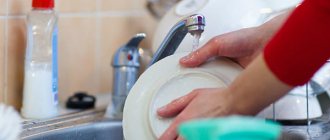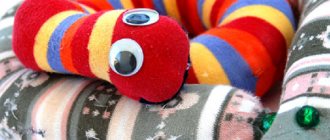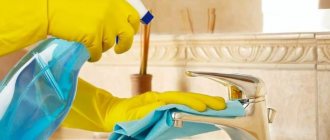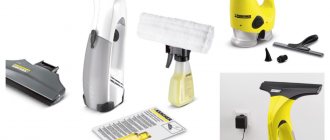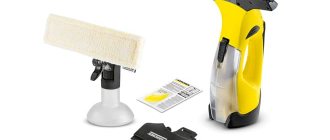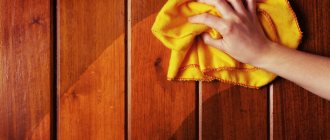December 18, 2019
The beauty of makeup done at home largely depends on the quality of decorative cosmetics, efforts and skills, good tools and compliance with hygiene standards. A significant part of the tool set are brushes and sponges, which are used almost every day. This means that not only wear and tear occurs, but also contamination. How often are they cleaned? According to dermatologists, cosmetologists and professional makeup artists, every woman should make it a point to clean her brushes regularly. This is a good and correct habit!
Why care is so important
Regular restoration of the original appearance allows you not only to preserve your beauty, but also to extend the life of the tools for creating makeup. “Hygiene procedures” should be carried out especially often on samples that contain natural hair. It literally attracts dust particles and becomes very dirty over time.
If you do not properly care for your sponges and brushes, the condition of your beauty arsenal will deteriorate, which will certainly affect the quality of your makeup and your skin. Dirt on the pile and spongy surface of the sponge is a favorable environment for the growth of bacteria. Therefore, rashes appear on the face, over which insufficiently clean natural or artificial hairs often slide. You can even get an infection under the skin by neglecting the rules for caring for tools for daily makeup.
Detergents
The choice of products for cleaning brushes is varied. Of course, there are special professional products: it can be gel, shampoo, spray, etc., which are usually very effective and help to carry out the cleansing process as quickly as possible. However, some of them contain alcohol, which can damage the pile if used frequently.
Cleaning brushes can be superficial or deep, which is why different products are needed. It's no secret that many women prefer their own method of cleaning makeup tools. Of course, not everyone has silicone structured applicators, mitts and brush cleaning mats that help break up and remove stubborn makeup residue. But in every home there is always one of the following remedies:
- soap, which should be very gentle, with a moisturizing effect, since other types can make natural hair dry. For example, G&H NOURISH+ caring soap from Amway;
- antibacterial liquid soap to clean brushes;
- antiseptic – necessary for superficial instant disinfection;
- vegetable oils to remove remnants of cream-based decorative cosmetics before washing;
- dry or liquid hair shampoo. It is advisable to even choose a child’s one;
- wet hygienic or antibacterial wipes - needed for surface express cleaning. Essentials by ARTISTRY Makeup Remover Wipes or LOC Universal Wet Cleansing Wipes from Amway may come in handy;
- rinse-off or leave-in hair conditioner to moisturize natural hair fibers and make them soft;
- cotton pads, if you need to first remove the remnants of makeup with a particularly resistant structure using special means, and then wash the brush;
- paper towels or napkins needed for drying.
Interestingly, the top best products for cleaning brushes include warm water and mild soap. Many people like baby shampoo (you need to take it in a 1:4 ratio), especially if a drop of tea tree oil is added to the solution as a strong antimicrobial agent. Such a product could be G&H Baby Baby Shampoo from Head to Toe with a neutral pH level.
Is it possible to wash makeup brushes with soap and how often should you do it?
Synthetics can be cleaned in a soapy solution - this will not affect its characteristics. But natural hair requires special, extremely careful handling, since the use of certain products can cause a change in the quality of application of cosmetics. Choosing the wrong method can cause your hair to become frizzy.
Many people are concerned about another important question: how often should you give your makeup tools a “bath day”? The frequency of care depends on what your brushes are intended for:
- For applying lipstick and foundation
Wash after each new use - that is, every day. Artificial pile collects especially a lot of bacteria and dust. In addition, fat remains on it with remnants of lipstick and foundation. If you don't get rid of it, the makeup will fail.
- For powder, eye shadow, blush
Such tools from the beauty arsenal should be cleaned once a week or as needed in case of severe contamination. In this case, you need to act extremely carefully so as not to damage the integrity of the pile - not a single hair should fall out. You need to be especially careful with the foundation - if after cleaning it remains loose, it will be very difficult to achieve ideal lines and uniform shading.
Daily cleaning rules for beauty tools
Professional makeup artists wash and disinfect brushes after each client. And this is correct, because bacteria living on the skin of one person can easily be transferred with a dirty brush to the skin of another. There is no such risk at home. If the brushes are individual, you can only transfer your own bacteria to your skin. True, they have multiplied considerably. After all, if we wash ourselves every day, the situation is different with brushes.
When using makeup tools, take care of their hygiene
How often to wash brushes and sponges for powder, foundation and decorative cosmetics
Care is divided into superficial cleaning, which is recommended after each use of brushes, and deep cleaning. There is no consensus on the frequency of deep cleaning. Some sources advise washing all brushes once a week or even a month. This is acceptable as long as daily surface cleaning is performed. One caveat: brushes for liquid and cream products, and especially a brush for liquid eyeliner, should be washed every day. The fatty, moist environment of these products is a sanatorium for bacteria. One day is enough for them to multiply in incredible quantities and cause skin irritation upon repeated use. This is especially dangerous if the brush is intended for eyeliner.
Recommendations for caring for cosmetic instruments:
- Brushes and sponges for foundation, concealer and other liquid or cream products, as well as eyeliner and lip brush are recommended to be washed after each use;
- brushes for powder and blush should be washed once a week for daily use;
- Wash eyeshadow applicators once every three days;
- It is enough to wash the puff once a week.
How to clean tools after each use
Makeup remover wipes and disinfectant are used for this purpose. First, the brushes are cleaned of cosmetic residues, then disinfected, if these two functions are not combined in one product.
- Wipe the tools with a cloth until they are clean. You can use micellar water for this purpose.
- There is another interesting way - dry cleaning with any microfiber cloths. According to the manufacturer, they remove 99.9% of bacteria.
- To free your brushes from product residues, it is convenient to use special ribbed mats or mittens.
- After cleaning, treat your brushes with a disinfectant.
A special ribbed mat will help you wash your brushes.
Disinfectants and their use
- Professional products for quick cleaning - sprays, liquids, lotions. The spray is sprayed onto the brush, and a napkin is moistened with lotion. You can pour a small amount into a glass and dip the bristles of the brush into it. Such products are good because they simultaneously clean and disinfect instruments. The special formula allows the brushes to dry in a few seconds.
- A disinfectant available to everyone is sold in pharmacies - chlorhexidine.
- Another disinfectant that can be found in every home is table vinegar. Mix it with water in a 1:2 ratio and soak the brushes in the solution for a few minutes, then rinse with running water.
- For brushes with synthetic bristles, you can use a mixture of hydrogen peroxide and water in a 1:1 ratio. Rinse your brushes in this mixture and rinse with clean water.
- Professionals sometimes use alcohol for this purpose. At home, it can only be used for brushes made of synthetic fibers, since such treatment will damage natural bristles. Dry your brushes well after treatment so that any remaining alcohol evaporates and does not cause irritation or dry skin.
- Alcohol lotions are excellent for disinfecting brushes. Simply spray the product onto the brush and wipe it with a dry cloth. But you shouldn't use it all the time.
How to properly clean and wash makeup brushes at home
Let’s say right away that there are special care products for them. They are convenient and easy to use. If you have the opportunity to purchase professional cleaners, do so.
How to properly use products intended not only for makeup artists, but also for amateurs? First, let's tell you what not to do:
- Dilute the cleaner with water and leave the brush in it. Some people forget about it for 10 or even 20 minutes. Such careless handling will simply turn the hairs sour.
- Roughly rub the instrument on a napkin with the product applied to it. This will fluff up the pile, it will lose its shape, and many hairs may fall out.
We advise you to use the special liquid correctly:
- Apply the product to a damp brush.
- Rub into hairs and rinse off the applied cleanser.
- Blot with a cloth and shape the fibers into the desired shape.
If the pile is natural, the liquid is applied generously - for deeper penetration and impregnation. Synthetics can be washed as follows: pour a little product into the cap and dip the brush into it. Afterwards it is thoroughly washed under running water and dried or cleaned with a cloth.
The described method is universal for most professional cleaners. Some argue that there is no need to rinse the pile additionally. However, most products contain ingredients that can cause allergies or irritation if they come into contact with the face, so those with sensitive skin are better off playing it safe and getting rid of any residue left on their hair. In addition, the instructions for use of some formulations contain appropriate instructions. If it is missing, you can skip this step.
We told you how to properly wash your makeup brushes if you have a special liquid for cleansing and disinfection on hand. But what about those who don’t have it?
- You can use mild shampoo (for children).
- Another option is simple antibacterial soap.
But don't forget that:
- Lipstick and foundation brushes tend to stick together. So, when washing them with a professional product, in water with the addition of shampoo or soap, you need to thoroughly clean the pile with your fingers - to the very ends. At the same time, you cannot pull the hairs or split them, rub them, press on them - all this leads to deformation.
- You should treat tools for blush, eye shadow and powder differently. They are simply dipped into water with foam to rinse the head afterwards without touching the lint itself. After the procedure, you can lightly squeeze the damp surface with a soft cloth. This must be done carefully so as not to deform it.
- You can dry makeup tools in an inclined, vertical or horizontal position. Optimal drying is at room temperature, gradual and thorough.
- How to wash sponges that constantly get dirty? For perfect cleaning, you need to soak them for a few minutes. To do this, you need to prepare a solution in advance from water with the addition of mild antibacterial soap or shampoo, and then put a sponge in it. Then you can gently squeeze it to get rid of excess liquid, rinse it under running water, and let it dry in the open air. The sponge surface should be washed after each use.
Homemade brush cleaner
You can prepare your own composition for quickly cleaning brushes. For this you will need:
- 250 ml distilled or melt water;
- 50 ml alcohol;
- 1 tbsp. a spoonful of liquid dishwashing detergent;
- 1 tbsp. spoon of baby shampoo.
Operating procedure:
- Mix the ingredients and pour the composition into a spray bottle.
- Spray the brushes and wipe thoroughly on a paper towel to remove dirt. After this treatment, the brushes dry for 5 minutes, since the product contains alcohol.
- If you don’t have a spray bottle on hand, moisten a napkin or cloth with lotion and wipe your brushes with it.
The disadvantage of this lotion is that detergents remain on the hands, and this is harmful for the skin. In addition, alcohol does not have the best effect on natural hair. Yes, professional products also contain it, but the amount of alcohol is strictly adjusted so as not to damage the brushes.
You should not use alcohol lotions to clean cosmetic instruments used by allergy sufferers or people with sensitive and problem skin. It is better to rinse your brushes or dry clean them and disinfect them.
How to prepare a brush cleaning spray - video
How to clean makeup brushes: tips for those with problem skin
If your skin is oily or prone to acne, you should focus not only on cleansing itself, but also on disinfecting the hair. For this, there are special liquid products, sprays, which should be used at least 3 times a week.
A good alternative to professional cleaners is chlorhexidine, which can be bought at any pharmacy. You can use it in its pure form, or you can add it to a prepared soap solution or water with mild shampoo.
Drying brushes correctly
After washing and disinfecting, it is important to dry the instruments properly.
- Gently squeeze clean brushes with your palm. Do not squeeze too hard to avoid damaging the lint. After this, blot with a paper napkin or terry towel to remove excess moisture.
- Brushes should not be dried near heat sources or in drafts. Don't try to speed up the process with a hairdryer. It is better to lay out wet tools on a napkin placed on the edge of the table. Place them so that the handles lie on the table and the pile part hangs freely over the edge.
To dry, brushes are laid out on a towel along the edge of the table.
A mitten will help get rid of dirt
The latter method may seem revolutionary, but it is becoming more and more popular every day. We are talking about using a special silicone mitten. There are several sections on it - each of them has a different texture and pattern. There are surfaces:
- for rinsing and washing the pile;
- for disinfectant solution;
- for deep cleaning;
- for squeezing (only suitable for tools intended for applying foundation).
This unique and unusual product will be useful not only to makeup artists, but also to amateurs who want to find a universal and effective product. Some people think that a mitten can be washed without soap, but this is a misconception - you need to apply a cleanser or shampoo to its surface.
Finally, let us remind you that the quality of makeup depends not only on what cosmetics you use, but also on what brushes you use to apply it. At Dream Minerals you will find tools for the perfect blending of eye shadow, corrector, primer, concealer, lipstick, powder, blush, as well as multifunctional options with synthetic bristles. With proper care, the professional components of your beauty arsenal will not deform and can serve you for many years.
Tips for processing sponges and beautyblenders
For those who use beautyblender sponges to apply foundation, it is important to know that this item requires thorough cleaning. Such products contain fatty components, which can only be washed off with soap or fatty compounds. And this needs to be done after each use.
- Lather with a damp sponge. It is more correct to use a product specially designed for this purpose (soap or gel), which is often sold along with a sponge.
You can purchase special soap for washing sponges and brushes.
- Knead the sponge thoroughly and wash until foam appears. Then rinse it with water, pressing from the center to the edges to expel the dirt out.
- If the sponge is very dirty, dip it in olive oil and knead it thoroughly to soak it completely. After this, lather and knead again, then rinse with clean water. If the oil is not completely removed, repeat the wash.
- Dry the sponges at room temperature on a paper or cloth napkin.
The sponge is convenient for applying foundation, but the tool must be washed after each use.
How to wash a beautyblender and makeup brushes - video
How to properly wash flat sponges and puffs
Flat sponges and puffs are made from various materials. But all of them also need to be washed.
- Wash the sponges with water and baby shampoo.
- Pre-treat heavily contaminated areas with olive or hydrophilic oil. Makeup remover is also suitable.
- Rinse off any residue with running water. For your puff, add a drop of conditioner or balm to bring back the fluffiness.
- Gently squeeze with your palms between two layers of paper or terry towel, shake the puff.
- Dry by spreading on a dry cloth.
Recommendations
We will also give some photo recommendations regarding the cleaning process, the direction of washing and cleaning inside the pile threads.
| Use a simple hair conditioner to lubricate your brushes after washing. They will not be affected by hard water and will be soft and smooth. |
| Seal the joint between the pile and the metal base. This way you can more reliably protect the tool from water, which will not lead to rust later. |
| Do not twist the brushes or move them vertically across your palm. The washing direction is strictly horizontal, the pile faces one direction. Do not flatten it so as not to break the thin threads. |
| When using soap for everyday cleaning, always lather your palm first and only dip the tips into the solution. |
| Use the special thread to rinse the bristles of the brushes. It is convenient because the depth of the cuts does not allow you to insert the tool far, reaching the base and fastening. |
Tip: By following some simple tips, you can easily rid your old brushes of damage and residue with your own hands, returning them to their original appearance.
How to restore damaged hair
And at the end, advice from our technologists (please note that we are talking only about M.Art brushes made of natural hair - not synthetic!):
If the brush hair is jammed (not broken, but jammed - as in the photo), then with the help of hot water you can fix everything.
Dip the entire hair bundle of the brush into boiling water for a few seconds, and then use your hands to give the working part the desired shape - level it out. The hotter the water, the faster the brush will straighten; the hair in hot water will become more flexible.
Let us repeat once again that this only works with good quality natural hair brushes! If you are not confident in the quality of your CMs, then do not risk correcting them.
The effect of dirty brushes on facial skin
Dirty brushes can cause rashes and pimples on your face. They can also irritate the skin and lead to serious infections. Dirty brushes can even cause conjunctivitis. They also accelerate the aging of human skin and lead to clogged pores.
Dirty makeup brushes spread bacteria
Under a microscope, on dirty brushes you can see the remains of bacteria that develop in a favorable environment. Such microorganisms are considered harmless, but can affect the appearance of acne on the face.
It is important to wash new makeup brushes immediately after purchasing them. Their bristles may be coated with harmful chemicals or simply dust or dirt.
How to properly store makeup brushes
Case
The best storage place is a brush case. It can be used both at home (stationary) and for carrying brushes. The cover prevents mechanical damage to the hairs and also protects the brushes from dust and harmful environmental influences.
Makeup brushes are tightly secured in the cells of the case, which, when carried in a horizontal position, prevents oscillatory movements of the brush, in which the hair hits the wall of the bag.
Tube
A tube is often used for home storage. It can be placed on a surface when doing makeup. The tube also has a lid that protects the CM from the environment. But, unfortunately, many people use a tube to carry brushes in a horizontal position, and this has a negative effect on the bristles. In the tube, the CMs do not lie tightly enough and can hit the tube’s machines, damaging the working part. Hair may become wrinkled or broken.
For the same reason, there is no need to carry, for example, a powder brush without a case in a woman’s purse. The hairs will definitely break off.
Cup
Unlike the tube, the glass does not have a lid. Due to the lack of protection, makeup brushes stored this way are more likely to accumulate dust. Accordingly, with this storage method, CM needs to be washed more often.
What types of foundation brushes are there?
In many ways, a good, even complexion depends on the correct application of foundation. With the help of professional brushes it is easy to achieve the correct application of the product. Of course, this can be done with your fingers, a sponge or a sponge, but it is the brush that ensures flawless and even distribution of the foundation over the entire surface of the face.
We offer a list of the most convenient brushes for applying foundation:
- DuoFibra Brush from MAC This brush is shaped like a duofibra and has long been used by professional stylists to apply foundation. The brush has noticeable white fibers at the very tip. The special shape helps to apply the foundation on the face in a very thin and even layer. This is very easy to do: a little foundation is squeezed onto a hard surface, then stirred with a brush and applied to the skin of the face with light circular movements;
- Perfect Foundation brush from A very convenient brush in the form of a spatula. It is made of artificial fiber, the tip has a completely even cut. Suitable for applying both light and very thick foundations;
- Curved Brush 150 Degree Application from This brush looks unique as it has a very interesting curved handle. The fiber is completely artificial. The brush is more suitable for applying liquid foundation;
- Japonesque beveled brush. This brush is from a famous Japanese brand. It is shaped and similar to a paint brush. Made from artificial bristles, used for foundation of any consistency;
- Master Class Brush by M.AC This is a fairly popular cosmetic tool slightly similar to a toothbrush. The oval brush is capable of providing an even application for foundations of any thickness. Used both by professional makeup artists and in everyday life;
- Brush with sponge PR Professional. A very interesting brush that combines a brush and a sponge at the same time. The brush is not very suitable for tinting small areas of skin;
- Mary Kay tapered brush. If a girl has never used a brush to apply foundation before this moment, then it is with this brush that she should begin to apply the foundation correctly. It is more suitable for liquid textures, perfectly blending the product over the entire skin;
- Kabuki brush from Givenchy. A very cute brush with a fluffy ball at the end. It is 100% natural. Used for both liquid and powder foundations. It is especially convenient for applying not only cream, but also powder.
Editor's choice: Fashionable makeup 2022: photos of current trends for girls and women

